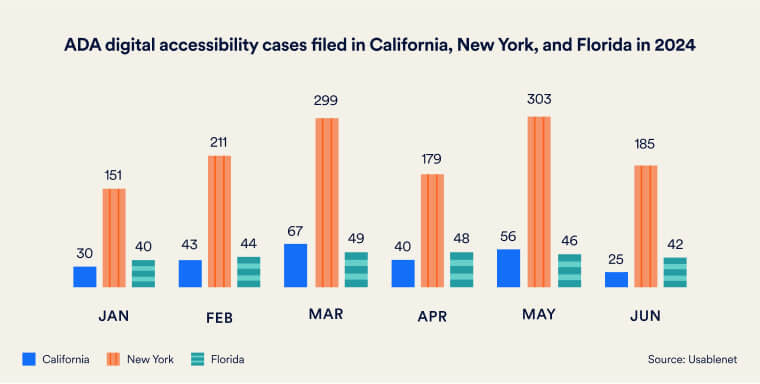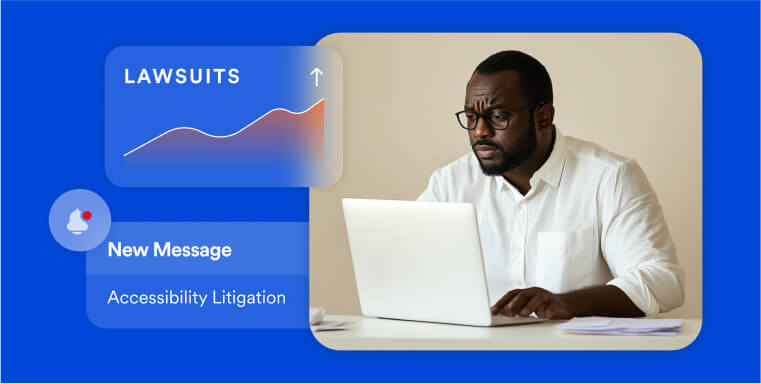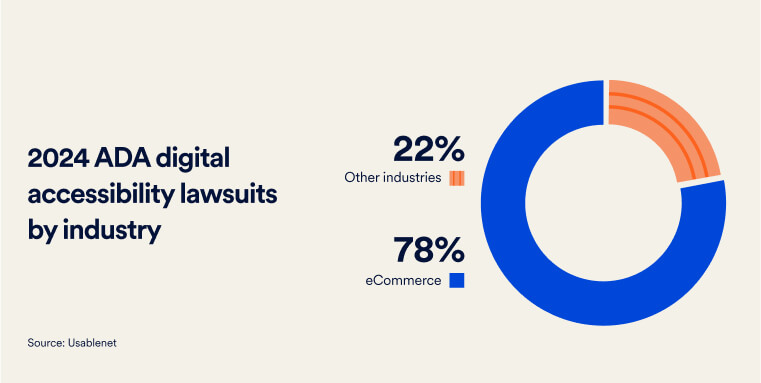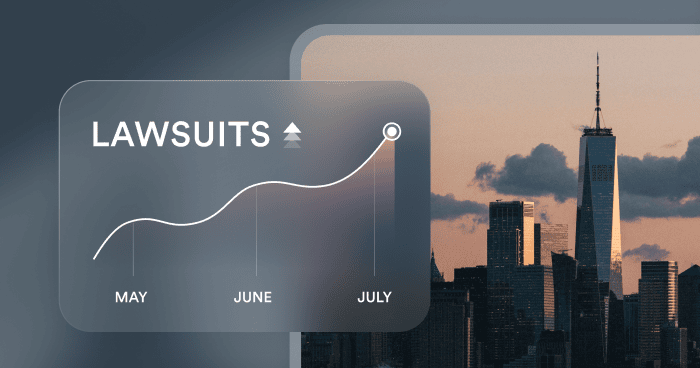The information presented within this guide is aimed at website owners seeking to learn the ropes of web accessibility and to create a more inclusive online environment for people with disabilities. Technical elements are described in layman’s terms, and, as a rule, all topics pertaining to the legalities of web accessibility are presented in as simplified a manner as possible. This blog has no legal bearing, and cannot be relied on in the case of litigation.
Digital accessibility is no longer just a nice-to-have; it’s a must for every business. In addition to being the right thing to do, it’s also legally required, falling under the Americans with Disabilities Act (ADA).
Lawsuits against businesses with inaccessible websites have been on the rise for the past decade, particularly in New York state. Companies that fail to ensure their websites, mobile apps, or digital content are accessible to all users, including those with disabilities, are finding themselves at legal risk.
Understanding the latest developments in digital accessibility lawsuits is essential for businesses of all sizes, especially those serving New York’s market.
New York takes the lead in accessibility litigation
Digital accessibility lawsuits are most prevalent in New York state. While accessibility-related legal action occurs across the country, the highest number of claims occur in New York’s state and federal courts, making it a critical focus area for companies operating in or selling goods and services to customers in this state.
Here's a breakdown of cases in California, New York, and Florida from January through June:

- January: 30 cases in California, 151 in New York, 40 in Florida
- February: 43 cases in California, 211 in New York, 44 in Florida
- March: 67 cases in California, 299 in New York, 49 in Florida
- April: 40 cases in California, 179 in New York, 48 in Florida
- May: 56 cases in California, 303 in New York, 46 in Florida
- June: 25 cases in California, 185 in New York, 42 in Florida
You don’t need to be located in New York to feel the impact of this, either. As long as you sell something to customers in New York, you can face legal action there.
Accessibility lawsuits on the rise

The number of digital accessibility lawsuits has steadily grown over the past six years. From 2,314 cases in 2018 to 4,220 in 2023, the trend shows no sign of letting up, despite a slight dip projected for 2024.
By midyear 2024, around 4,001 cases were expected by the end of the year, reflecting the ongoing scrutiny of digital platforms.
This rise has prompted businesses to rethink their digital strategies, ensuring compliance to mitigate the risk of costly legal battles.
One of the reasons for the slight decline in 2024 appears to be the fact that judges are now scrutinizing ADA claims more carefully, asking for more specific details from plaintiffs.
While this has led to fewer lawsuits, it underscores the importance of maintaining strong accessibility standards, as plaintiffs continue to file claims and secure settlements.
Industries under scrutiny: e-commerce and restaurants
Certain industries face more ADA digital accessibility websites than others. E-commerce websites are the primary focus of digital accessibility claims in 2024, accounting for 78% of lawsuits, followed by food service websites at 11%.

This is likely due to a high level of scrutiny among e-commerce websites as well as the fact that the vast majority of e-commerce sites are not accessible. According to accessiBe’s audit of 10 million e-commerce brands, less than 3% were compliant and met accessibility standards.
For e-commerce websites, accessibility is essential not only to meet legal standards but also to reach a broader customer base. Inaccessible websites exclude a significant portion of the population, including individuals who rely on assistive technology to navigate online.
By ensuring accessibility, e-commerce businesses can offer a seamless shopping experience to all users, from browsing products to completing purchases. This not only fosters inclusion but can actually benefit businesses, increasing reach, improving website performance, and even boosting revenue.
No business is too small
A common misconception is that only large corporations need to worry about digital accessibility lawsuits. The reality, however, is that smaller companies should pay attention to accessibility too. In fact, 66% of businesses facing accessibility lawsuits in 2024 had annual revenues under $25 million.
Regardless of a company's size or annual revenue, failing to address digital accessibility can lead to legal challenges. Making your website accessible is not just an important way for businesses of any size to be inclusive, it’s also a legal requirement.
Start your accessibility journey today
Given the legal and financial risks, businesses should prioritize digital accessibility to mitigate risk and ensure that their website is open to all users. Accessibility is not just a legal requirement; it also promotes inclusion, is good for business, and enhances customer trust and loyalty. By investing in accessibility, companies can mitigate legal risks while improving their brand reputation.
The best way to ensure compliance is by adhering to the Web Content Accessibility Guidelines (WCAG) 2.1 at the AA level, widely recognized as the global standard for web accessibility.
Businesses can take proactive steps by performing regular accessibility audits, making necessary adjustments, and considering a wide variety of available solutions to streamline the process.
If your business is concerned about digital accessibility compliance, accessiBe can help. Our ecosystem of solutions, like our automated tool accessWidget, help you make your website conformant with WCAG standards.
By implementing these tools, businesses can address accessibility issues effectively, mitigating the risk of receiving demand letters or facing legal action wherever they’re located.
_______________________________________________________________
Source: Useablenet's 2024 Mid-year Report.
Frequently asked questions about ADA digital accessibility lawsuits in New York
Q1. Why are businesses serving or located in New York particularly vulnerable to ADA digital accessibility lawsuits?
A1. New York leads the United States in the number of digital accessibility filings. Its courts accept lawsuits against any entity whose website is used by a New York resident, regardless of the business’s physical location. Added statutory tools—like the New York State Human Rights Law or New York City Human Rights Law—give plaintiffs broader bases to bring claims.
Q2. Do small businesses face the same risk in New York as large companies?
A2. Yes. A significant number of suits filed in New York target companies with annual revenues under $25 million. The message is clear: business size does not exempt you from risk if your website is inaccessible.
Q3. Which industries are most often targeted by digital accessibility lawsuits in New York?
A3. E-commerce sites dominate the filings, making up a large portion of new lawsuits. Restaurants and food-service businesses—through online ordering or menus—also face elevated risk. These industries are frequent targets because their interfaces are transactional and public-facing.
Q4. Does being headquartered outside New York protect you from lawsuits filed there?
A4. No. Even if your business is based elsewhere, if your website is accessible by New York residents (for example you serve them online), you can be sued under New York state or city law.
Q5. Are there any legal defenses or dismissal trends in New York courts?
A5. Yes. Some recent cases show courts requiring plaintiffs to specify how they were harmed, when they visited the website, what they attempted to do, and what barriers they encountered. But the existence of these hurdles doesn’t eliminate risk—it simply shapes how businesses must respond.
Q6. What practical steps should a business take to reduce its digital accessibility risk in New York?
A6. Conduct an audit of your website to evaluate whether it meets WCAG 2.1 Level AA (or equivalent) standards, fix barriers (navigation, form interaction, image descriptions), maintain a documented accessibility policy, publish an accessibility statement, and implement monitoring so changes don’t create new issues.
Q7. Why is accessiBe a helpful choice for businesses facing New York digital accessibility exposure?
A7. accessiBe offers end-to-end accessibility solutions that help businesses identify website barriers, remediate them, and monitor accessibility long-term. With the best in AI and human expertise, accessiBe supports your efforts to reduce legal risk, meet digital accessibility standards, and operate in high-exposure jurisdictions like New York.





